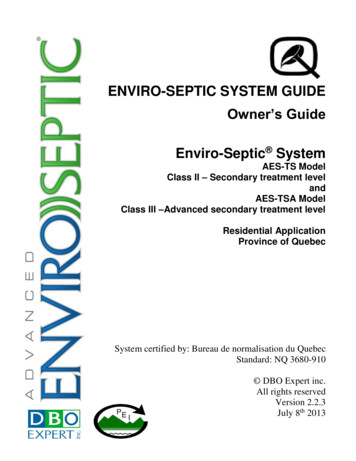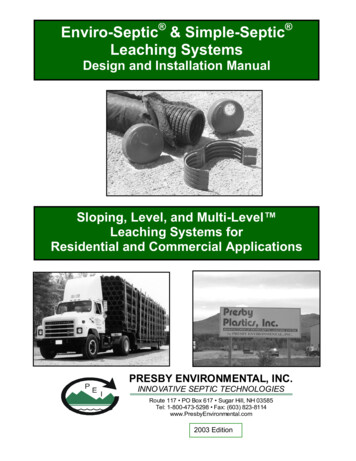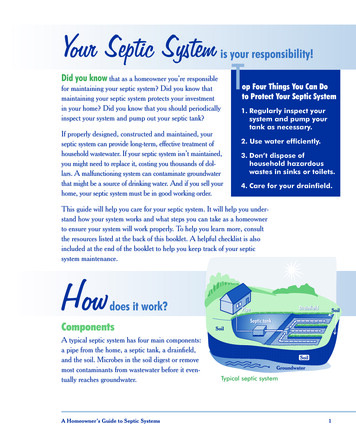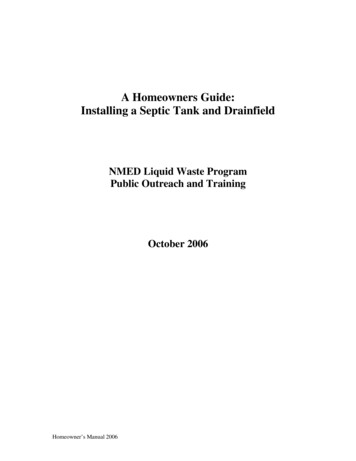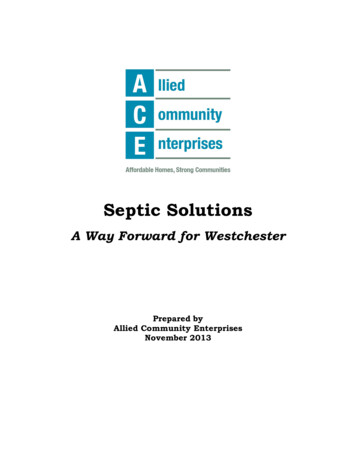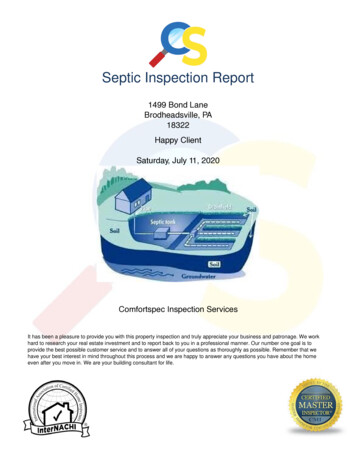
Transcription
Septic Inspection Report1499 Bond LaneBrodheadsville, PA18322Happy ClientSaturday, July 11, 2020Comfortspec Inspection ServicesIt has been a pleasure to provide you with this property inspection and truly appreciate your business and patronage. We workhard to research your real estate investment and to report back to you in a professional manner. Our number one goal is toprovide the best possible customer service and to answer all of your questions as thoroughly as possible. Remember that wehave your best interest in mind throughout this process and we are happy to answer any questions you have about the homeeven after you move in. We are your building consultant for life.
Executive SummaryThis is a summary review of the inspectors' findings during this inspection. However, it does notcontain every detailed observation. This is provided as an additional service to our client, and ispresented in the form of a listing of the items which, in the opinion of your inspector, merit furtherattention, investigation, or improvement. Some of these conditions are of such a nature as to requirerepair or modification by a skilled craftsman, technician, or specialist. Others can be easily handledby a homeowner such as yourself.Often, following the inspector's advice will result in improved performance and/or extended life of thecomponent(s) in question. In listing these items, your inspector is not offering any opinion as to who,among the parties to this transaction, should take responsibility for addressing any of these concerns.As with most of the facets of your transaction, we recommend consultation with your Real EstateProfessional for further advice with regards to the following items:INLET BAFFLESEPTIC REPORT1: Baffle is broken/missing. Recommend repairing as needed.LEVEL OF SOLIDSSEPTIC REPORT2: Given the level in the septic tank it is recommended to have the tank pumped and the baffles andtank evaluated when empty by the septic management company that performs the pump out. Thiswill also serve as a reference point. A septic system should be pumped out at a minimum of every 4years.Copyright 2010-2020,Comfortspec Inspection Services, Jason Damato 07112030Page 2 of 8
Table of ContentsExecutive Summary.2Introduction.4SEPTIC REPORT.4Care And Maintenance Of A Septic System.6
IntroductionThe Happy ClientReport1499 Bond LaneBrodheadsville, PA18322This report is a "snapshot" of the property on the date of the inspection. The septic system and allrelated components will continue to age with time and may not be in the same condition years fromnow.Anywhere in the report that the inspector recommends further review, it is strongly recommendedthat this be done. This report is not intended for use by anyone other than the client named herein.No other persons should rely upon the information in this report. Client agrees to indemnify, defendand hold inspector harmless from any third party claims arising out of client's unauthorizeddistribution of the report.By accepting this inspection report, you acknowledge that you have reviewed and are in agreementwith all of the terms contained in the standard contract provided by the inspector who prepared thisreport.SEPTIC REPORTWith proper maintenance the septic system should be expected to function satisfactorily and isunlikely to create an unwanted condition. This statement does not constitute an assurance that thesystem will continue to perform satisfactorily. Only that if maintained the system should be adequatebased on the given knowledge.When possible, a modified hydraulic load test is performed using a fluorescent dye designed to showflaws in the septic system. This was introduced at a sink drain along with at least 150 gallons ofwater.Roots in the drain field and near tank area can penetrate the drain lines and shorten the lifeexpectancy of the system. Be sure to keep these areas clear.LOCATION OF SEPTIC TANKRear of home.DISTANCE FROM WELL TO SEPTIC SYSTEMAt least 50 plus feet from the well to the septic tank.At least 100 plus feet from the well to the drain field.SEPTIC TANK SIZE AND TYPEConventional system.Concrete tank.SEPTIC TANK LIDConcrete lid at holding tank.Septic lid(s) fully intact and functioning as designed.Copyright 2010-2020,Comfortspec Inspection Services, Jason Damato 07112030Page 4 of 8
INLET BAFFLEBaffle is broken/missing. Recommend repairing as needed.The Happy ClientReport1499 Bond LaneBrodheadsville, PA18322LEVEL OF SOLIDSGiven the level in the septic tank it is recommended to have the tank pumped and the baffles andtank evaluated when empty by the septic management company that performs the pump out. Thiswill also serve as a reference point. A septic system should be pumped out at a minimum of every 4years.RISERNone PresentA riser installed would aid in locating the tank lid in the future. This can be performed by a qualifiedseptic management company.OPERATING CONDITION OF SEPTIC TANKThe tank is full and needs to be pumped.DRAIN FIELDRear of home.This drain field worked properly at the time of the inspection. During the test water was ran into thesystem for 30 minutes allowing approximately 150-200 gallons of water. Throughout the test waterwas observed flowing freely and continuously into this drain line with no rise in the level of fluids.Soil borings above this line showed no staining in either the soil or the slag. The slag was clean anddry. There was no waste water ponded in the slag after the inspection was completed.LANDSCAPING AND VEGETATIONThere are no plantings in the immediate area of the drain field.Copyright 2010-2020,Comfortspec Inspection Services, Jason Damato 07112030Page 5 of 8
Care And Maintenance Of A Septic SystemThe Happy ClientReport1499 Bond LaneBrodheadsville, PA18322How can you avoid a septic system nightmare? don't dump chemicals down your drains don't let vehicles drive over your drain field ( they can crush the drainpipes) don't pour grease and oils into the system the less water you use, the better stagger heavy water usage, i.e. showers, clothes washing, bathing. don't flush dyed or heavy toilet tissue don't flush feminine hygiene products avoid washing quantities of chlorine bleach into the systems do not grow trees too near the field, particularly willows (their roots can damage the drainfield)What About Additives ?Beware of septic-additive products that claim to eliminate the need for septic tank pump-outs. Thebacteria that helps break down organic matter in your septic tank are naturally occurring; you shouldnot need to add more. Studies consistently show most septic-additive products have little effect onseptic systems, according to Michael Hoover at the Department of Soil Science, North Carolina StateUniversity. Although septic additives do contain biologically-based materials like bacteria, enzymesand yeast, they also can contain harmful solvents. Some additives, which claim to degrease yoursystem, may damage your drain field, contaminate your soil and groundwater, and in some states,be illegal.SEPTIC SYSTEMSThe purpose of a septic system is to create an environment where beneficial bacteria destroypathogens and take up excess nutrients in wastewater. Wastewater enters the septic tank, which isessentially a storage unit from a high inlet pipe and exits through a lower outlet pipe. Inside the tanklightweight solids like fibers, hair and grease float to the top and form the scum layer. Sediments thatsink to the bottom comprise the sludge layer. Clearer wastewater drains out into the leach field, alsoknown as the drain field. The longer wastewater remains in the tank (retention time), the greater thechance anything that could potentially clog the drain field will sink or float. To allow, more time forsettling, newer septic tanks feature one or more baffles or dividers to slow down the passage ofwastewater from inlet to outlet.Naturally occurring anaerobic (oxygenless) bacteria in the tank start the biological breakdownprocess, but usually do not kill pathogens or remove toxic chemicals. After the septic tank has settledout solids, clarified wastewater is dispersed through perforated pipes into the soil. In Septic TankPractices soil is the key to clean water. It acts as a "physical strainer, chemical renovator and abiological recycler" for the wastewater passing through it. Your soil absorption system may be calleda leach field, leach bed, soil absorption field, seepage bed or mound, but all act similarly. Beneathand to the sides of the pipes, a black, jellylike mat or biomat forms. This thin layer of anaerobicorganisms helps regulate the flow of wastewater to the soil and preys on potentially pathogenicbacteria, viruses and parasites. It also converts nutrients into a form that can be used by plants orreleases nutrients into the atmosphere as gases. The biomat also is a common trouble spot forclogging, as it has low permeability.Failing to pump out your septic system or discharging too much wastewater down the drain can leadto a buildup of organic material, which causes the biomat to grow too thick. Your leach field may be aseries of trenches into which wastewater flows by gravity. If your system is older, your leach field maybe buried 5 feet deep. More modern leach fields use drip-irrigation lines, usually buried only inchesCopyright 2010-2020,Comfortspec Inspection Services, Jason Damato 07112030Page 6 of 8
The Happy ClientReport1499 Bond LaneBrodheadsville, PA18322under the surface to keep wastewater in the zone of microbiological activity and within the root zonesof plants. Leach fields work best when the soil surrounding them is well-drained. Don't do anythingthat could compact the soil, such as driving heavy trucks over it (a lawn mower is fine). Grass plantedover your leach field helps keep the soil aerated. Don't plant trees with deep roots, especiallyinvasive species such as willows. If yourproperty does not have permeable soils or the soil is too permeable for filtering, your leach field mayneed to be built up with sand to create a mound system. Instead of distributing wastewaterunderneath the soil surface, wastewater is pumped up onto the mound, where it percolates through alayer of sand before contacting native soil.PUMPING IT"A few times a year, I'll be called out to pump a system, and the homeowner doesn't know where itis" Joe a septic contractor says. "After a little probing, we'll find it under their new house addition or adriveway! When you buy a house, locate the septic system. Better yet, check out the whole systembefore you buy the house." Some people will tell you that they've never pumped out their systems. Inwarmer climates and back when we didn't use so much water, toxics and non biodegradableproducts, this might have worked. But these days, going long periods without pump-outs is askingfortrouble. After a new home is built, have the system pumped within the next six to 12 months,especially if toxic chemical finishing agents were rinsed into it. Unfortunately there is no way ofknowing if the various people who built your new home treated the system the way you will. Moststates offer convenient folders and charts on which you can calculate pumping frequency and keepaccurate maintenance records. A septic system must be pumped out periodically to remove bothfloating scum and the sludge on the bottom. Failure to do this can result in an expensive repair oreven replacement of the entire system. Experts recommend pumping your septic tank every two tothree years, unless you use grease traps and particle filters.SEPTIC CAREA properly designed and well-sited system that's also maintained well can be effective andenvironmentally responsible. We live in different times, and we can't take wastewater managementfor granted. It's important that we respect our septic systems as the living machinery that they are.It's not hard, but like any living thing, it needs daily awareness and effort. Paying attention to thesesimple septic tips can significantly extend the life of your system. Don't Go with the Flow. Preventlarge volumes of water from entering your system all at once. A flood of water reduces the timewastewater is retained in the tank, leaving fewer opportunities for solids to settle out and foranaerobic bacteria to start the breakdown process. It also can stir up sediment and flush it into theleach field, causing clogs. Route roof drains and basement drainagetile water outside of the septicsystem and away from the leach field. Drain water from pools, hot tubs and roof drains to a ditch orseparate dry well. To reduce water consumption further, install faucet aerators and low-flowshowerheads, which give more force to less water. Take shorter showers and use showerheads thatallow you to easily turn them off when you're lathering up. And shut off water while you're shaving orbrushing your teeth. Wash only full loads in the dishwasher, or hand wash dishes with a basin ofsoapy water and a basin of clear rinse water. Front-loading washing machines use almost half thewater of top-loading washers. Wash only full loads, and adjust load level settings for small loads.Distribute wash loads evenly throughout the week to avoid overloading the system with largevolumes of water. Consider installing a gray -water system to use shower and wash water forirrigation if allowed. Your local health agency may permit a system that is properly sized,Copyright 2010-2020,Comfortspec Inspection Services, Jason Damato 07112030Page 7 of 8
The Happy ClientReport1499 Bond LaneBrodheadsville, PA18322self-contained andallows no gray-water to come to the surface. If you have a water softener system, usepotassium-ionexchange resins instead of sodium-ion exchange resins. They're a little more expensive, but theyaremuch easier on your system. Recharge your water softener as infrequently as possible to reducewater use, and re-route the water softener recharge water outside the septic system if permitted byyour health department. It does not need to be treated, and the salts can damage your leach field.About 60 percent of the water used in most American homes is used in the bathroom, and most of itgoes to flushing toilets. To conserve water and increase the life of your septic system, considerinstalling a low-flush toilet. Most low flush or ultra-low-flush toilets use 1.6 gallons per flush; someflush with less than a gallon. Don't flush paper towels, feminine sanitary products and other slowdegrade materials, like cat litter, in the toilet.KEEP IT CLEANTake a load off your septic system whenever you can by composting kitchen scraps and usingbiodegradable and nontoxic cleaning products. Many toilet bowl cleaners, antibacterial agents anddrain cleaners can kill beneficial bacteria in your system. Dispose of all solvents, paints, antifreezeand other chemicals through local recycling and hazardous waste centers. Never let wash waterfrom latex paint on brushes or rollers go down the drain and into the septic system. Usephosphatefree liquid detergents instead of powders, which can clog your leach field, or switch toLiquid soap instead. Although small amounts of chlorine appear to have little effect on septicsystems, use hydrogen peroxide-based bleaches to keep this potential carcinogen out of thewatershed.FILTER OUT FIBERSKeep fibers and particles out of the septic system. Many of today's fabrics are made of recycledplastic soda bottles and other nondegradable fibers that can clog your leach field. A SepticProtector attaches to your washing machine drain to remove these fibers. Septic tank filtersalso can be added to the outlet of your septic tank to keep fibers and particles out of the leach field.For more information about your septic system (complete with graphics)visit: http://www.epa gov/owm/septic/pubs/homeowner guide long.pdfThe inspection performed on the septic system is based on a snapshot in time and does notdetermine future functionality only current operation. The inspection is limited to current functionalityon the day of the inspection only. I bough we do our absolute best to find every possible concern,underground components are not visible and may conceal hidden flaws limiting the inspection.Copyright 2010-2020,Comfortspec Inspection Services, Jason Damato 07112030Page 8 of 8
DISTANCE FROM WELL TO SEPTIC SYSTEM At least 50 plus feet from the well to the septic tank. At least 100 plus feet from the well to the drain field. SEPTIC TANK SIZE AND TYPE Conventional system. Concrete tank. SEPTIC TANK LID Concrete lid at holding tank. Septic lid(s) fully intact and functioning as designed. The Happy Client Report 1499 Bond .




